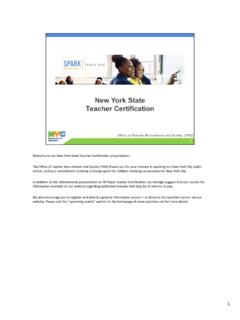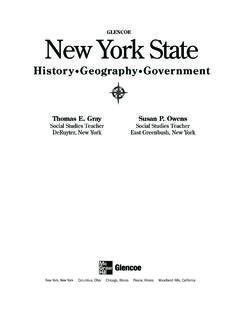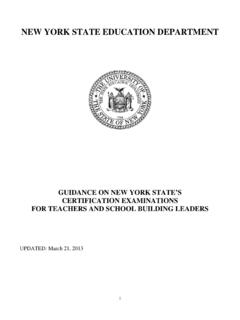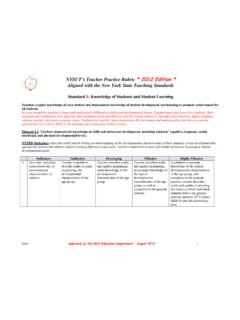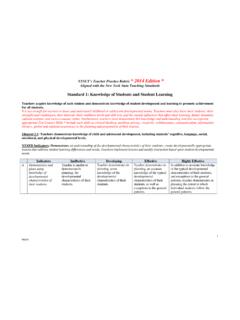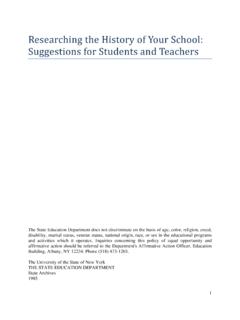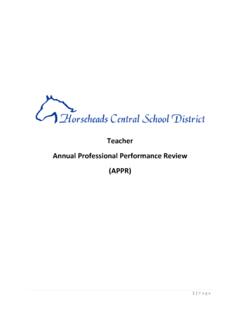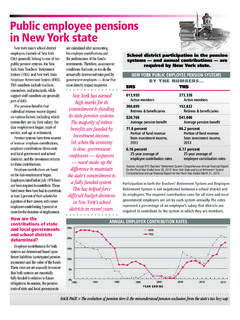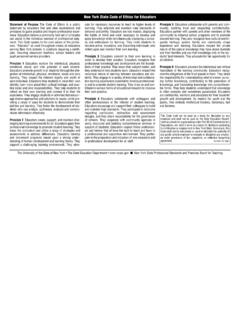Transcription of Teacher Shortage? What Teacher Shortage? - New …
1 May 2017 Teacher Shortage? what Teacher Shortage? This report was researched and written by Paul Heiser, senior research analyst. It was edited by David Albert, director of marketing, communications and research, and designed by Barbara Bennett, communications associate. Much has been written nationally and locally about a Teacher shortage . The recession that began in 2008 caused many school districts to lay off teaching staff and cut programs to cope with losses in state fi nan-cial aid. This, in turn, caused large numbers of poten-tial teachers to turn to other career paths where the hiring outlook was more promising. As the economy has rebounded, schools have started resurrecting programs and looking for teachers to fi ll the new positions. The demand for qualifi ed teachers has increased and, in some instances, outpaced supply.
2 According to NYSSBA s analysis, Teacher shortages in New York are not widespread for all instructional areas, but rather are concentrated in specifi c subjects, most notably science, special education, foreign languages, mathematics, and English instruction for students whose primary language is not English. Geographically, Teacher shortages are not widespread in New York. They tend to be concentrated in certain regions of the state. Teacher shortage patterns observed in 2016 were similar to what they were fi ve years earlier. Subject areas in which the greatest percentages of teachers taught without certifi cation were in the areas of bilin-gual education, English as a second language, foreign language, home economics, technology and trade education. Existing shortages appear to be related to a mis-match in supply and demand between the types of teachers coming out of Teacher preparation pro-grams and the kinds of teachers most in demand by schools.
3 For example, New York regularly produces a surplus of elementary level teachers, yet not enough teachers in areas such as science, math and special education. This report identifi es both a number of strategies school districts can employ at the local level to alleviate Teacher shortages and state-level strategies for policymakers to consider, such as: aligning student teaching placements with subject shortage areas; addressing pay differentials for hard-to-staff subjects; using data to refi ne Teacher recruitment and hiring, and using social media in recruitment Summary1If you have picked up a newspaper or magazine within the past year, chances are you have seen more than a few headlines announcing a looming Teacher shortage in the But are these warnings real, or are they just the sky is falling rhetoric?
4 Is there a Teacher shortage across the board in all subjects, or just in certain subjects? Do they impact the whole country, or just certain states or specifi c regions?Exploring answers to these questions is crucial. Having an adequate number of qualifi ed teachers is vital to student learning. In times of shortage schools have few good options, such as staffi ng classrooms with teachers who are not fully prepared and qualifi ed; relying on substitutes; increasing class sizes; and canceling courses. All of these options have the potential to detract from the quality of instruction students report gives school leaders and policymakers a clearer idea of the Teacher shortage landscape in New York. We provide an overview of the national Teacher shortage , explore the extent of the Teacher shortage in New York, examine what subjects and regional areas are most affected, and offer recommendations for state policymakers and local school boards to address any 2A Teacher shortage is typically defi ned as the inability to fi ll vacancies at current wages with individuals quali-fi ed to teach in the fi elds needed.
5 1In September 2016, the Learning Policy Institute (LPI), an education research and policy think tank in Palo Alto, Calif., published a report titled, A Coming Crisis in Teaching? to chronicle the extent of the Teacher shortage throughout the nation. Using federal data from the Department of Education s National Center for Education Statistics, LPI projected a nation-wide Teacher shortage of 145,000 by 2025 if current supply and demand trends continue. 2 LPI identifi ed several reasons why demand for teachers is outstripping supply. Student enrollments are project-ed to grow in the next decade because of higher birth rates and immigration;3 pupil- Teacher ratios are pro-jected to revert from an average of about 16 to 1 in 2016 to pre-recession levels of about to 1, based on modeling of both historical patterns and economic conditions; Teacher attrition of about 8 percent annu-ally, due mostly to dissatisfaction with the profession; and Teacher supply is shrinking as fewer people enter Teacher preparation programs; enrollment in Teacher prep programs declined by 35 percent between 2009 and 2014.
6 4 According to a May 2016 report by the Education Commission of the States (ECS), a recent longitudinal study of a nationally representative cohort of teach-ers by the National Center for Education Statistics found that Teacher turnover, as measured annually by the combined percentage of teachers who moved to other schools or districts or left the profession, was 46 percent after fi ve years in the profession. These data, coupled with concerns about a growing K-12 student population, suggest the makings of supply defi cits in the Teacher labor ECS report said Teacher shortages may be attributed in large part to the overall condition of the Teacher labor It cited data from the Department of Education and ACT that fewer high school graduates are majoring in education and fewer college students are becoming teachers.
7 The report also noted that many of those who do enter the profession report overall job dissatisfaction, a loss of autonomy, and limitations in feedback, recognition, advancement and reward, all of which contribute to Teacher turnover. The National Council on Teacher Quality (NCTQ), a Washington, think tank that advocates for tougher Teacher standards, believes warnings about a national Teacher shortage are overstated. Kate Walsh, the president of NCTQ, said Teacher shortages are confi ned to certain regions and certain subject areas. Even with the normal ebb and fl ow in the numbers of individuals who enter Teacher prep programs (and we are in an ebb), the actual Teacher shortage is no different than it was 2, 5, 10, or 15 years ago, said Walsh. By that I mean that all schools, as they have for decades, continue to struggle mightily to fi nd certain kinds of teachers (STEM, ELL, special education).
8 7 Moreover, Walsh contends that Teacher shortages are due more to a misalignment between the types of teachers coming out of Teacher preparation programs and the kinds schools actually need, rather than a lack of teachers applying to Teacher preparation programs. Higher education institutions have continually over-produced teachers, yet shortages remain, said Walsh. Why? Because Teacher preparation programs gradu-ate an overabundance of elementary school teachers, but the fi elds in which they are most needed are in ar-eas such as science, math, special education and English as a second language. 8 The LPI report agrees that Teacher shortages gener-ally are not national in nature, but differ from state to state and among subject The report said that subjects such as math, science and English as a second language have seen the greatest shortages.
9 It also said Teacher shortfalls have been particularly acute in spe-cial education: 48 states plus the District of Columbia have identifi ed shortages of teachers in special educa-tion and related the report also points out that since a quarter of teachers move to other states at some point in their careers, and many leave the profession because of bar-riers to transferring their licenses and pensions, solving national labor market problems would be benefi of National Data3 what s the Picture in New York?To determine the extent of the Teacher shortage in New York, NYSSBA looked at three separate sources of information: annual report data from the Department of Education; a NYSSBA analysis of teach-er certifi cation data from the State Education Depart-ment; and a NYSSBA survey of school superintendents across the state.
10 The combination of these data is then used to draw conclusions about the nature of the Teacher shortage in New Department of Education dataThe Department of Education issues an annual re-port on Teacher shortages in each state. The document is intended to provide information to both recent graduates of Teacher preparation programs and trained, experienced teaching professionals about the subject areas and geographic regions with shortages in pre-K through grade The most recent report, published in August 2016, did not fi nd widespread shortages across New York for the 2016-17 school year. Rather, the subject areas where Teacher shortages exist were specifi cally in bilingual education, career and technical education, and special education. The report said New York City is experiencing short-ages in a greater number of subject areas, including arts (all grades), bilingual education (all grades), English (grades 7-12), health education (all grades), foreign languages (all grades), reading/literacy (all grades), sci-ences (grades 7-12), and special education.


